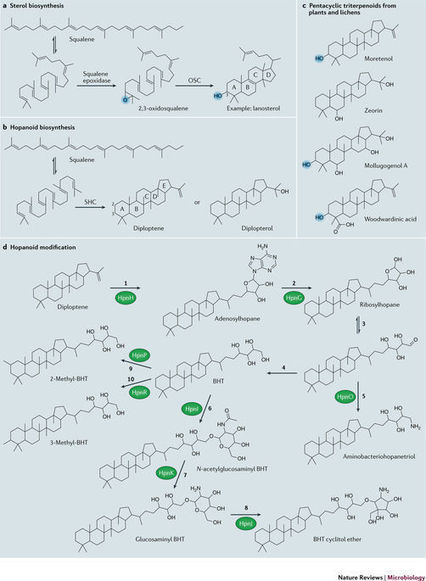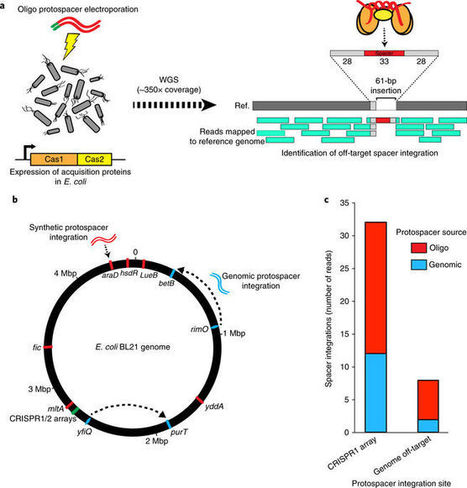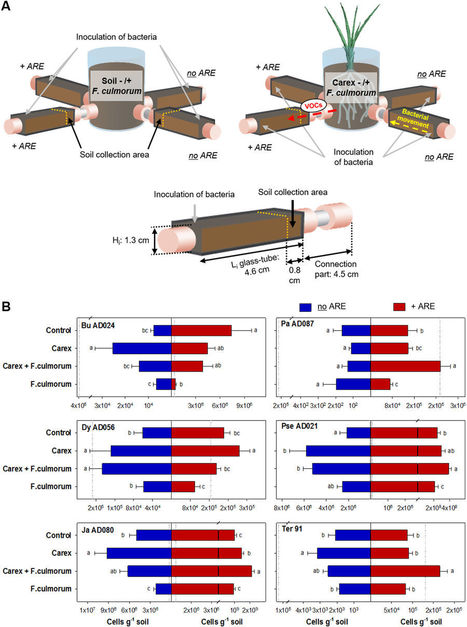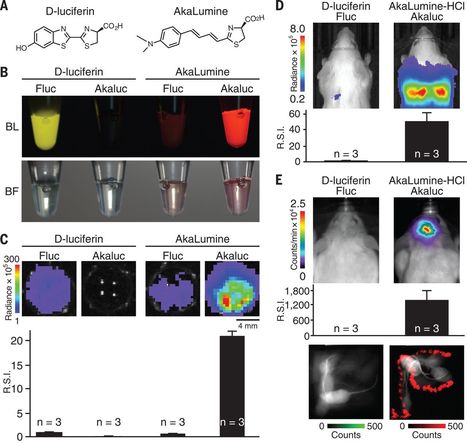 Your new post is loading...

|
Scooped by
?
February 25, 2018 12:34 PM
|
Under iron limitation, bacteria scavenge ferric (Fe3+) iron bound to siderophores or other chelates from the environment to fulfill their nutritional requirement. In gram-negative bacteria, the siderophore uptake system prototype consists of an outer membrane transporter, a periplasmic binding protein and a cytoplasmic membrane transporter, each specific for a single ferric siderophore or siderophore family. Here, we show that spontaneous single gain-of-function missense mutations in outer membrane transporter genes of Bradyrhizobium japonicum were sufficient to confer on cells the ability to use synthetic or natural iron siderophores, suggesting that selectivity is limited primarily to the outer membrane and can be readily modified. Moreover, growth on natural or synthetic chelators required the cytoplasmic membrane ferrous (Fe2+) iron transporter FeoB, suggesting that iron is both dissociated from the chelate and reduced to the ferrous form within the periplasm prior to cytoplasmic entry. The data suggest rapid adaptation to environmental iron by facile mutation of selective outer membrane transporter genes and by non-selective uptake components that do not require mutation to accommodate new iron sources.

|
Scooped by
?
February 23, 2018 6:12 PM
|
Actinobacteria is a phylum of gram-positive bacteria, and members of bacteria belonging to this phylum are classified into six classes, namely Acidimicrobiia, Actinobacteria, Coriobacteriia, Nitriliruptoria, Rubrobacteria, and Thermoleophilia. Among the six different classes, members of the actinobacteria class are the most dominant and contain one of the largest genera, Streptomyces, with 961 distinct species. Members of phylum actinobacteria are ubiquitous in nature and have been isolated from various extreme environments (high temperatures, pH, salinities, pressure, and drought) and are associated with plants growing in different habitats. The rhizospheric actinobacteria are the most dominant in nature and they are of great economic importance to humans due to their huge contributions to soil systems. Based on a comprehensive literature analysis members of phylum actinobacteria have been reported from different genera such as Acidimicrobium, Actinomyces, Arthrobacter, Bifidobacterium, Cellulomonas, Clavibacter, Corynebacterium, Frankia, Microbacterium, Micrococcus, Mycobacterium, Nocardia, Propionibacterium, Pseudonocardia, Rhodococcus, Sanguibacter, and Streptomyces. Actinobacteria can be utilized as bioinoculants for sustainable agriculture as they can enhance plant growth and yield both by directly promoting plant growth by the fixation of atmospheric nitrogen, the solubilization of minerals such as phosphorus, potassium, and zinc, the production of siderophores and plant growth hormones such cytokinin, auxin, and gibberellins, and by indirect plant growth promotion via production of antagonistic substances by inducing resistance against plant pathogens. The actinobacteria has been proved to have immense importance in biotechnological applications in various industrial and agricultural processes that are discussed in this chapter.

|
Scooped by
?
February 23, 2018 5:28 PM
|
Hopanoids, which resemble sterols and are found in the membranes of diverse bacteria, have left an extensive molecular fossil record. Today, hopanoid-producing bacteria remain abundant in various ecosystems, such as the rhizosphere. In vitro, hopanoids contribute to bacterial stress resistance, which may help explain their ability to facilitate beneficial plant–bacteria interactions. However, given that hopanoids can also serve as carriers for plant hormones and that plants themselves make hopanoid-like compounds, it is likely that other mechanisms are additionally at play. In closing, we remind the reader of the words of John F. Kennedy when explaining what was needed to send astronauts to the Moon. “We choose to go to the Moon! ... We choose to go to the Moon in this decade and do the other things, not because they are easy, but because they are hard; because that goal will serve to organize and measure the best of our energies and skills...”. Replacing the words 'go to the Moon' with 'study lipids' provides fitting inspiration for tackling one of the next great challenges in microbiology. It is time for lipids to get the attention they deserve, and the study of hopanoids is an excellent place to begin.

|
Scooped by
?
February 23, 2018 4:53 PM
|
Four nucleotide bases carry all the information an organism needs to live and function. Can this limited set of bases be expanded to carry more information? Now, a new study by Floyd Romesberg at The Scripps Research Institute reports that introducing unnatural nucleotides into DNA results in the incorporation of novel amino acids into proteins in E.coli. While other research groups have engineered cells to incorporate unnatural amino acids into cellular proteins, Romesberg focused on expanding the information stored in DNAso that semi-synthetic organisms could create new proteins and perform unnatural functions. “The natural system was there, and I wanted to augment the natural system,” said Romesberg.

|
Scooped by
?
February 23, 2018 3:53 PM
|
Simultaneous quantification of transcripts of the whole bacterial genome allows the analysis of the global transcriptional response under changing conditions. RNA-seq and microarrays are the most used techniques to measure these transcriptomic changes, and both complement each other in transcriptome profiling. In this review, we exhaustively compiled the symbiosis-related transcriptomic reports (microarrays and RNA sequencing) carried out hitherto in rhizobia. This review is specially focused on transcriptomic changes that takes place when five rhizobial species, Bradyrhizobium japonicum (=diazoefficiens) USDA 110, Rhizobium leguminosarum biovar viciae 3841, Rhizobium tropici CIAT 899, Sinorhizobium (=Ensifer) meliloti 1021 and S. fredii HH103, recognize inducing flavonoids, plant-exuded phenolic compounds that activate the biosynthesis and export of Nod factors (NF) in all analysed rhizobia. Interestingly, our global transcriptomic comparison also indicates that each rhizobial species possesses its own arsenal of molecular weapons accompanying the set of NF in order to establish a successful interaction with host legumes.

|
Scooped by
?
February 23, 2018 11:23 AM
|
|

|
Scooped by
?
February 23, 2018 6:15 PM
|
The adaptation phase of CRISPR–Cas immunity depends on the precise integration of short segments of foreign DNA (spacers) into a specific genomic location within the CRISPR locus by the Cas1–Cas2 integration complex. Although off-target spacer integration outside of canonical CRISPR arrays has been described in vitro, no evidence of non-specific integration activity has been found in vivo. Here, we show that non-canonical off-target integrations can occur within bacterial chromosomes at locations that resemble the native CRISPR locus by characterizing hundreds of off-target integration locations within Escherichia coli. Considering whether such promiscuous Cas1–Cas2 activity could have an evolutionary role through the genesis of neo-CRISPR loci, we combed existing CRISPR databases and available genomes for evidence of off-target integration activity. This search uncovered several putative instances of naturally occurring off-target spacer integration events within the genomes of Yersinia pestis and Sulfolobus islandicus. These results are important in understanding alternative routes to CRISPR array genesis and evolution, as well as in the use of spacer acquisition in technological applications.

|
Scooped by
?
February 23, 2018 5:33 PM
|
Plants release a wide set of secondary metabolites including volatile organic compounds (VOCs). Many of those compounds are considered to function as defense against herbivory, pests, and pathogens. However, little knowledge exists about the role of belowground plant VOCs for attracting beneficial soil microorganisms. We developed an olfactometer system to test the attraction of soil bacteria by VOCs emitted by Carex arenaria roots. Moreover, we tested whether infection of C. arenaria with the fungal pathogen Fusarium culmorum modifies the VOCs profile and bacterial attraction. The results revealed that migration of distant bacteria in soil towards roots can be stimulated by plant VOCs. Upon fungal infection, the blend of root VOCs changed and specific bacteria with antifungal properties were attracted. Tests with various pure VOCs indicated that those compounds can diffuse over long distance but with different diffusion abilities. Overall, this work highlights the importance of plant VOCs in belowground long-distance plant–microbe interactions.

|
Scooped by
?
February 23, 2018 5:10 PM
|
Fungi and bacteria are found living together in a wide variety of environments. Their interactions are significant drivers of many ecosystem functions and are important for the health of plants and animals. A large number of fungal and bacterial families are engaged in complex interactions that lead to critical behavioural shifts of the microorganisms ranging from mutualism to pathogenicity. The importance of bacterial-fungal interactions (BFI) in environmental science, medicine and biotechnology has led to the emergence of a dynamic and multidisciplinary research field that combines highly diverse approaches including molecular biology, genomics, geochemistry, chemical and microbial ecology, biophysics and ecological modelling. In this review, we discuss most recent advances that underscore the roles of BFI across relevant habitats and ecosystems. A particular focus is placed on the understanding of BFI within complex microbial communities and in regards of the metaorganism concept. We also discuss recent discoveries that clarify the (molecular) mechanisms involved in bacterial-fungal relationships, and the contribution of new technologies to decipher generic principles of BFI in terms of physical associations and molecular dialogues. Finally, we discuss future directions for researches in order to catalyse a synergy within the BFI research area and to resolve outstanding questions.

|
Scooped by
?
February 23, 2018 4:42 PM
|

|
Scooped by
?
February 23, 2018 12:44 PM
|

|
Scooped by
?
February 23, 2018 11:19 AM
|
Bioluminescence imaging is a tremendous asset to medical research, providing a way to monitor living cells noninvasively within their natural environments. Advances in imaging methods allow researchers to measure tumor growth, visualize developmental processes, and track cell-cell interactions. Yet technical limitations exist, and it is difficult to image deep tissues or detect low cell numbers in vivo. Iwano et al. designed a bioluminescence imaging system that produces brighter emission by up to a factor of 1000 compared with conventional technology (see the Perspective by Nasu and Campbell). Individual tumor cells were successfully visualized in the lungs of mice. Small numbers of striatal neurons were detected in the brains of naturally behaving marmosets. The ability of the substrate to cross the blood-brain barrier should provide important opportunities for neuroscience research.
Science , this issue p. [935][1]; see also p. [868][2]
[1]: /lookup/doi/10.1126/science.aaq1067
[2]: /lookup/volpage/359/868?iss=6378
|



 Your new post is loading...
Your new post is loading...

















Selectivity for new siderophores (even chelator EDDHA) can be obtained by simple assays of suppressor selection on plates with high chelator. One can quickly evolve dedicated siderophore transporters at outer membrane to new siderophore families.